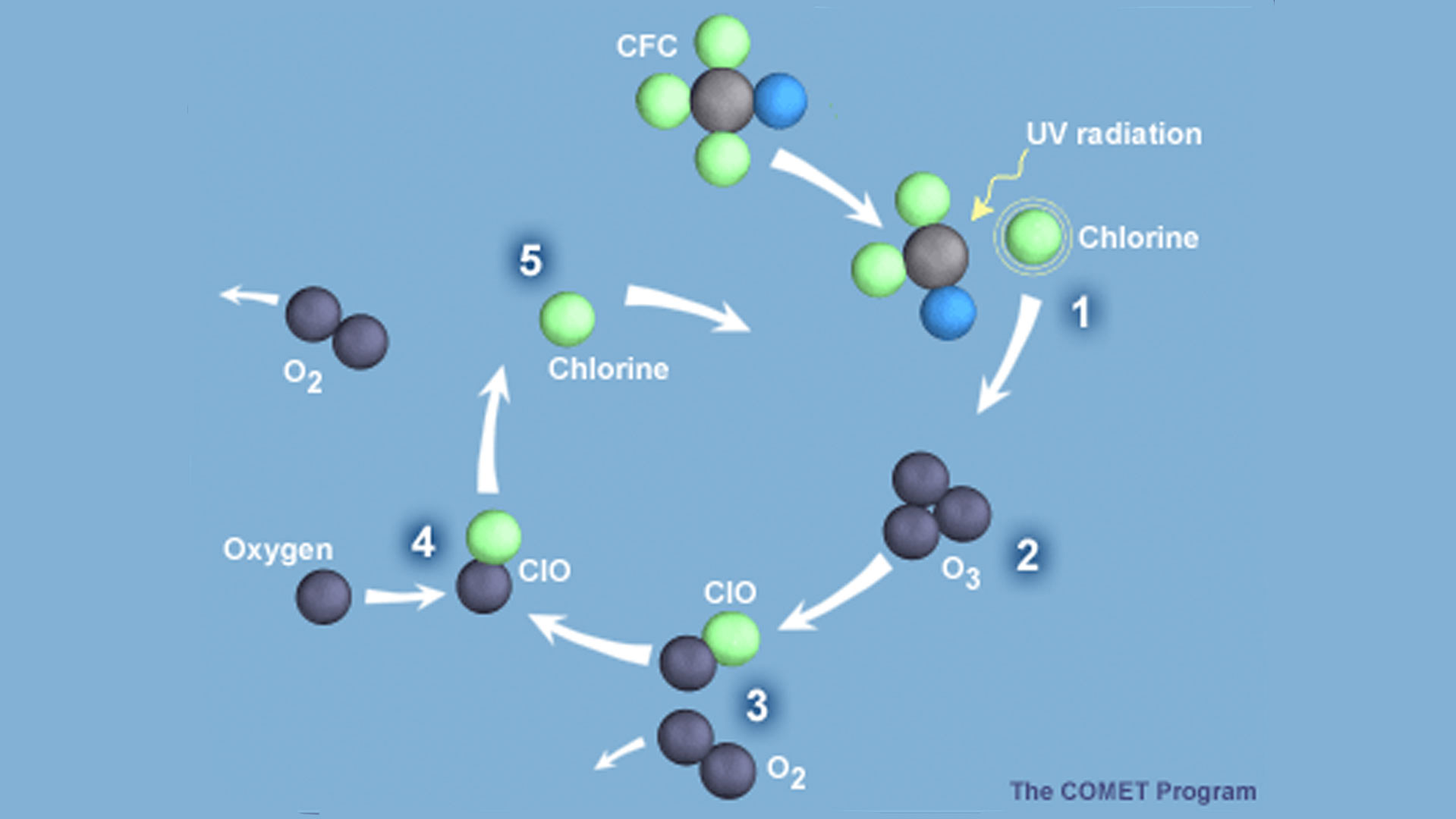 Once in the atmosphere, CFCs drift slowly upward to the stratosphere, where they are broken up by ultraviolet radiation, releasing the chlorine that catalytically destroys ozone. The destructive cycle of a chlorine atom is shown in the graphic.
Once in the atmosphere, CFCs drift slowly upward to the stratosphere, where they are broken up by ultraviolet radiation, releasing the chlorine that catalytically destroys ozone. The destructive cycle of a chlorine atom is shown in the graphic.
It’s been said that no single organism has affected the Earth’s atmosphere more than Thomas Midgley Jr., who invented the first of the CFC refrigerants known by the trade name Freon.
“This was the same guy, incidentally, who developed tetraethyl lead — the additive that was put in gasoline, that created such rampant pollution in the early 1900s,” said Kirsten Hendrickson, an organic chemist and science communication expert with Arizona State University’s School of Molecular Sciences.
These stable, nontoxic refrigerants changed the world, transforming food storage, expanding Sun Belt populations, even helping early movie theaters succeed. But they also wrecked the ozone layer — Earth’s shield against harmful ultraviolet radiation, as Hendrickson explained.
“Ultraviolet light does react with CFCs and, when it does so, it breaks the carbon-chlorine bond and releases a chlorine radical, which then zips around in the ozone layer, catalytically destroying ozone,” Hendrickson said.
Radicals are highly reactive atoms or molecules that contain at least one unpaired electron. This makes them needy; like the protagonist of a romantic comedy, they seek completion and leave destruction in their wake.
“One CFC can result in the destruction of hundreds of thousands of ozone molecules before it, itself, is quenched somehow,” Hendrickson said.
Here’s how it works: UV radiation knocks a chlorine atom off a CFC molecule, which then connects with an ozone molecule, which comprises three oxygen atoms. This breaks into a typical two-oxygen molecule and a chlorine monoxide molecule (ClO). Eventually, the ClO comes across a free oxygen molecule, which pairs with its oxygen, freeing the chlorine radical to cause more trouble.
The idea that CFCs might harm ozone was in the air even before a British team working in Antarctica in the mid-1980s discovered the ozone hole.
“There had been this indication that perhaps there would be a problem due to the CFCs leaking into the atmosphere. Once the hole in the ozone layer was discovered — in the '80s, of course — that made it obvious that this was no longer just a philosophical argument,” Hendrickson said.
The situation was dire. So, 30 years ago, the Montreal Protocol set complex timetables for phasing out CFCs by the mid-1990s and their provisional alternates, hydrochlorofluorocarbons (HCFCs), by 2010-2030, with the developing world lagging 10 or more years. The details are complicated — made more so by the fact that some favored refrigerants, like the popular hydrofluorocarbon (HFC) R-410A — have high global warming potential.
“The HFC has zero ozone depleting potential. However, it has tremendous global warming potential. And so we’re trading one problem for another,” Hendrickson said.
Hendrickson explained that global warming potential relates how much a molecule behaves like a greenhouse gas – that is, how much it absorbs and releases infrared radiation, aka heat energy – to equivalent molecules of carbon dioxide. Many CFCs and HFCs don’t stack up favorably.
“Depending on the specific HFC, these can be equivalent — each individual molecule — to hundreds, all the way up to more than 10,000, molecules of carbon dioxide.”
To make matters even fiddlier, some refrigerants with low ozone depletion and global warming potentials are less efficient, which expands their potential carbon footprint.
In other words, the fate of refrigerants remains unclear, said Mike Donley, president of Donley Service Center in Phoenix.
“I’m going to a meeting in a week or so talking about the next generation of refrigerant," Donley said. "So, even R-410A might not be around for much longer.”
Either way, as supplies of old chlorine refrigerant dwindle, prices will rise.
“In the last couple years, we’ve seen the price go up 50 percent,” Donley said. “It’s simple supply and demand. Price is going to go up when the supply decreases.”
Owners of older air conditioners have three basic options: use recycled chlorine refrigerants, buy a new unit or install a fairly pricey conversion kit.
Donley said conversion comes with advantages, but only under certain circumstances.
“The pluses are, obviously, you’re using a refrigerant that’s less expensive, and you’re using a refrigerant that’s environmentally friendly. The retrofit process, though, can be expensive. So, if you have a machine that’s, you know, over 10 years old, it really doesn’t pay to retrofit it,” Donley said.
He suggests weighing the unit’s age against the cost of each option. In Arizona, the average AC unit lasts about 12-15 years.
Meanwhile, in that portion of the stratosphere where ozone and elemental oxygen do their dynamic dance, natural reactions slowly restore the ozone balance. But it will take time, Hendrickson said.
“It’s not instantaneous. And so, even after we had, let’s say, six decades to get rid of the stratospheric chlorine, we still have a period of several decades during which the ozone layer will gradually be, through that natural pair of reactions, returning itself to its natural concentrations,” Hendrickson said.


By submitting your comments, you hereby give AZPM the right to post your comments and potentially use them in any other form of media operated by this institution.